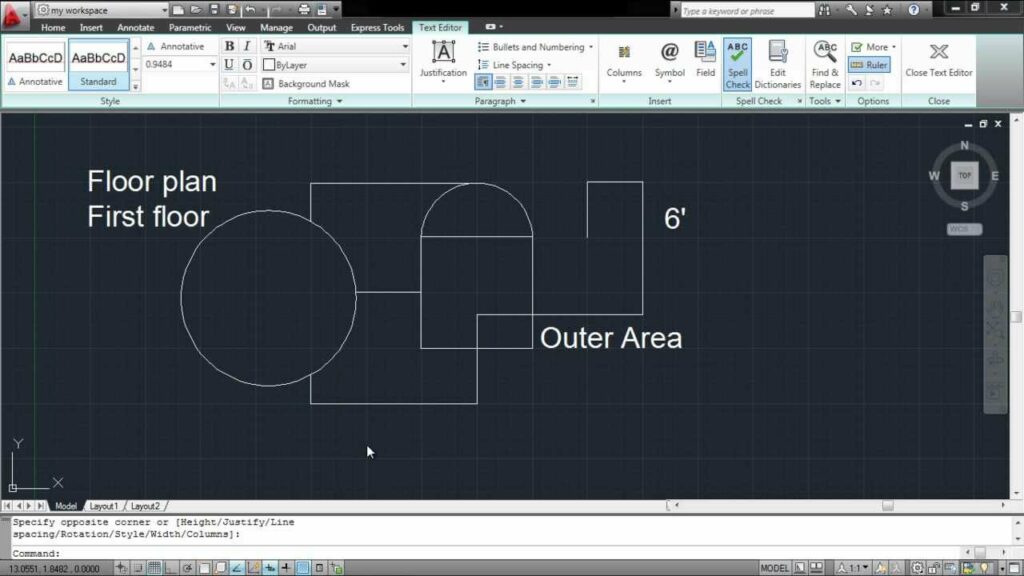Mastering AutoCAD: A Comprehensive Guide to Working with Text

In the realm of computer-aided design (CAD), text plays a pivotal role in communicating information, annotations, and labels within drawings. Mastering the techniques for working with text in AutoCAD is essential for creating clear, professional, and informative designs. Whether you’re an architect, engineer, designer, or drafting professional, understanding how to effectively work with text empowers you to convey critical details, enhance documentation, and streamline your workflow with precision and efficiency. In this comprehensive guide, we’ll explore the tools and techniques for working with text in AutoCAD, discuss their applications and functionalities, and provide step-by-step instructions to help you refine your drafting skills and unlock new possibilities in your design projects.
Understanding Text in AutoCAD:
Before delving into the specifics of working with text in AutoCAD, it’s essential to grasp the concepts and functionalities of text:
- Text Styles: In AutoCAD, text styles define the appearance and formatting of text elements, including font, size, justification, and spacing. Text styles allow users to maintain consistency across drawings and customize the appearance of text to suit specific project requirements.
- Text Objects: Text in AutoCAD is represented as text objects, which consist of one or more lines of text positioned within the drawing. Text objects can be single-line or multiline, and they can be edited and formatted using various tools and commands.
Working with Text in AutoCAD:
AutoCAD provides a range of tools and commands for creating, editing, and formatting text, allowing users to customize text elements to meet their specific design needs. Here’s how to work with text in AutoCAD:
- Creating Text:
- To create text in AutoCAD, use the Text command by typing “TEXT” in the command line or clicking on the Text tool in the Annotation panel on the Home tab of the Ribbon.
- Specify the insertion point for the text by clicking in the drawing area or entering precise coordinates.
- Enter the text content in the text editor dialog box and customize the text style, height, rotation angle, and other properties as desired.
- Click “OK” to insert the text into the drawing.
- Editing Text:
- To edit existing text in AutoCAD, use the Mtext (multiline text) or Dtext (single-line text) command.
- Select the text object you wish to edit and use the text editor dialog box to modify the text content, formatting, alignment, and other properties.
- Click “OK” to apply the changes to the text object.
- Formatting Text:
- AutoCAD offers a range of formatting options for text, including font selection, text height, text style, justification, and spacing.
- Use the Properties palette or the text editor dialog box to adjust text formatting properties as needed.
- Creating Multiline Text:
- To create multiline text in AutoCAD, use the Mtext command by typing “MTEXT” in the command line or clicking on the Multiline Text tool in the Annotation panel.
- Specify the insertion point and size of the multiline text box, and enter the text content in the text editor dialog box.
- Customize the formatting and alignment of the multiline text using the text editor options.
Advanced Techniques for Working with Text:
In addition to basic text creation and editing, AutoCAD offers advanced techniques for optimizing text usage and enhancing productivity:
- Text Styles and Standards: Define and manage text styles to maintain consistency and adhere to industry standards across drawings. Use the Text Style Manager to create and modify text styles and ensure uniformity in text appearance.
- Annotative Text: Utilize annotative text to automatically adjust text size and scale based on annotation scale settings, ensuring that text remains legible and proportional at different viewport scales.
- Text Alignment and Justification: Experiment with different text alignment and justification options, including left, center, right, top, middle, and bottom alignments, to achieve the desired layout and presentation of text elements.
- Text Fields and Variables: Incorporate text fields and variables to dynamically display information such as file names, dates, and sheet numbers within text objects, enabling automated updates and revisions.
Best Practices for Working with Text:
To maximize efficiency and maintain consistency when working with text in AutoCAD, consider implementing the following best practices:
- Plan Text Placement: Before inserting text into a drawing, plan the placement and alignment of text elements to ensure clarity, readability, and visual balance.
- Use Descriptive Text Styles: Create and use descriptive text styles that reflect the intended purpose and formatting of text elements, such as title text, body text, and annotation text.
- Avoid Excessive Text: Keep text concise and relevant, avoiding excessive text that may clutter the drawing or detract from the main design elements.
- Review and Proofread: Review and proofread text content to ensure accuracy, consistency, and compliance with project requirements before finalizing drawings for distribution or publication.
Conclusion:
Mastering the techniques for working with text in AutoCAD is essential for creating clear, professional, and informative drawings in various industries and applications. By understanding the functionalities of text objects, practicing their use in different design scenarios, and implementing best practices for efficiency and consistency, you can elevate your drafting skills and unlock new possibilities in your design projects. Whether you’re annotating drawings, labeling components, or documenting details, knowing how to work with text effectively will enable you to produce high-quality drawings with confidence and precision. With dedication, practice, and a commitment to continuous learning, you’ll become proficient in working with text in AutoCAD and excel in your CAD design endeavors.




